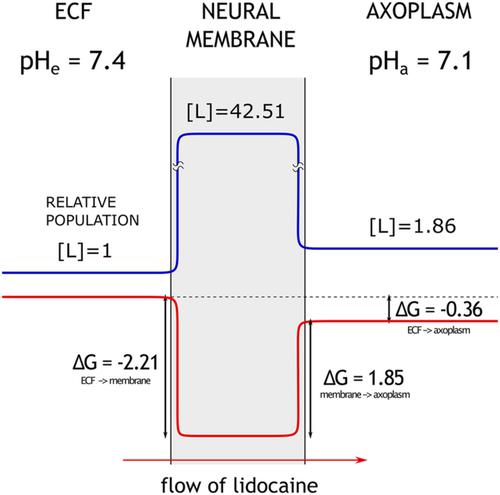当前位置:
X-MOL 学术
›
J. Phys. Org. Chem.
›
论文详情
Our official English website, www.x-mol.net, welcomes your
feedback! (Note: you will need to create a separate account there.)
Local anesthetics transfer relies on pH differences and affinities toward lipophilic compartments
Journal of Physical Organic Chemistry ( IF 1.9 ) Pub Date : 2021-08-19 , DOI: 10.1002/poc.4275 Hana Kavčič 1, 2 , Nejc Umek 3 , Neli Vintar 1, 2, 4 , Janez Mavri 4
Journal of Physical Organic Chemistry ( IF 1.9 ) Pub Date : 2021-08-19 , DOI: 10.1002/poc.4275 Hana Kavčič 1, 2 , Nejc Umek 3 , Neli Vintar 1, 2, 4 , Janez Mavri 4
Affiliation

|
Local anesthetics are weak bases and alter their properties in accordance with their protonation state, which depends on the environmental pH. We studied the transport dynamics of several local anesthetics from the extracellular fluid across biological membranes to the axoplasm, in order to understand the effect of pH on their pharmacodynamic properties. By using experimental pKa values and n-octanol/water partition coefficients, we calculated pH-dependent distribution coefficients and therewith associated relative populations and free energy profiles between extracellular fluid, membrane, and axoplasm. We estimated the local anesthetic capacity of neural tissue, using a simple 2D model. All values were calculated under physiological conditions and under the effect of local acidosis. Under physiological conditions, local anesthetics were most prevalent in the membrane. Change of free energy for transfer across biological membrane and the difference in relative population between extracellular fluid and axoplasm was dependent only on the difference of pH values between both environments, and not on pKa values. Estimated storage capacities for long-lasting local anesthetics are higher by a factor of 10 or 100 than for short-lasting local anesthetics. The membrane does not represent a barrier for local anesthetic diffusion. Local anesthetics move from the compartment with higher pH to the compartment with lower pH, due to favorable solvation free energy of protonated species. The rate of transfer across biological membrane is diffusion-controlled and is similar for all local anesthetics. Neural tissue has a higher storage capacity for highly lipophilic local anesthetics, which can explain their longer duration of action.
中文翻译:

局部麻醉剂转移依赖于 pH 值差异和亲脂性隔室的亲和力
局部麻醉剂是弱碱,会根据其质子化状态改变其性质,这取决于环境 pH 值。我们研究了几种局部麻醉剂从细胞外液穿过生物膜到轴浆的转运动力学,以了解 pH 值对其药效特性的影响。通过使用实验 pK a值和n-辛醇/水分配系数,我们计算了依赖于 pH 值的分布系数,以及相关的细胞外液、膜和轴浆之间的相关相对种群和自由能分布。我们使用简单的 2D 模型估计了神经组织的局部麻醉能力。所有数值均在生理条件和局部酸中毒作用下计算。在生理条件下,局部麻醉剂在膜中最为普遍。用于跨生物膜传递和细胞外液和轴浆之间的相对群体差异自由能的变化是仅依赖于pH值的两个环境之间的差异,而不是对PK一个值。长效局麻药的估计储存容量比短效局麻药高 10 或 100 倍。该膜并不代表局部麻醉剂扩散的障碍。由于质子化物质有利的溶剂化自由能,局部麻醉剂从具有较高 pH 值的隔室移动到具有较低 pH 值的隔室。跨生物膜的传输速率受扩散控制,并且对于所有局部麻醉剂都是相似的。神经组织对高亲脂性局麻药具有更高的储存容量,这可以解释它们的作用持续时间更长。
更新日期:2021-08-19
中文翻译:

局部麻醉剂转移依赖于 pH 值差异和亲脂性隔室的亲和力
局部麻醉剂是弱碱,会根据其质子化状态改变其性质,这取决于环境 pH 值。我们研究了几种局部麻醉剂从细胞外液穿过生物膜到轴浆的转运动力学,以了解 pH 值对其药效特性的影响。通过使用实验 pK a值和n-辛醇/水分配系数,我们计算了依赖于 pH 值的分布系数,以及相关的细胞外液、膜和轴浆之间的相关相对种群和自由能分布。我们使用简单的 2D 模型估计了神经组织的局部麻醉能力。所有数值均在生理条件和局部酸中毒作用下计算。在生理条件下,局部麻醉剂在膜中最为普遍。用于跨生物膜传递和细胞外液和轴浆之间的相对群体差异自由能的变化是仅依赖于pH值的两个环境之间的差异,而不是对PK一个值。长效局麻药的估计储存容量比短效局麻药高 10 或 100 倍。该膜并不代表局部麻醉剂扩散的障碍。由于质子化物质有利的溶剂化自由能,局部麻醉剂从具有较高 pH 值的隔室移动到具有较低 pH 值的隔室。跨生物膜的传输速率受扩散控制,并且对于所有局部麻醉剂都是相似的。神经组织对高亲脂性局麻药具有更高的储存容量,这可以解释它们的作用持续时间更长。











































 京公网安备 11010802027423号
京公网安备 11010802027423号